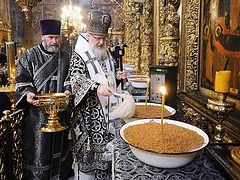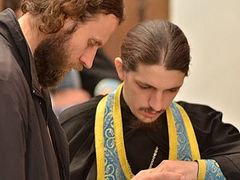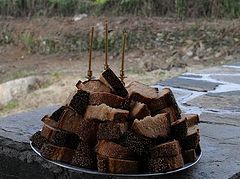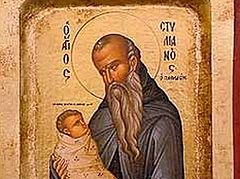On the Saturday of the first week of Great Lent, we commemorate an event which occurred in the year 356—a miracle of Great Martyr Theodore the Tyro ("the Recruit"), which continues to have great significance for Orthodox Christians even today, perhaps especially today.
* * *
Fifty years after the death of St Theodore, the emperor Julian the Apostate (361-363), wanting to commit an outrage upon the Christians, commanded the city-commander of Constantinople during the first week of Great Lent to sprinkle all the food provisions in the marketplaces with the blood offered to idols. St Theodore appeared in a dream to Archbishop Eudoxius, ordering him to inform all the Christians that no one should buy anything at the marketplaces, but rather to eat cooked wheat with honey (koliva).
In memory of this occurrence, the Orthodox Church annually celebrates the holy Great Martyr Theodore the Recruit on the first Saturday of Great Lent. On Friday evening, at the Divine Liturgy of the Presanctified Gifts following the prayer at the ambo, the Canon to the holy Great Martyr Theodore, composed by St John of Damascus, is sung. After this, kolyva is blessed and distributed to the faithful. The celebration of the Great Martyr Theodore on the first Saturday of Great Lent was set by the Patriarch Nectarius of Constantinople (381-397).
* * *
The Life of Great Martyr Theodore the Tyro ("the Recruit")
Commemorated on February 17/March 2
 St. Theodore the Tyro The Holy Great Martyr Theodore the Recruit (Tyro) was a soldier in the city of Alasium of the Pontine district (northeast province of Asia Minor, stretching along the coast of the Euxine, i.e. the Black Sea), under the command of a certain Brincus. They commanded him to offer sacrifice to idols. St Theodore firmly confessed his faith in Christ the Savior in a loud voice. The commander gave him several days to think it over, during which time St Theodore prayed.
St. Theodore the Tyro The Holy Great Martyr Theodore the Recruit (Tyro) was a soldier in the city of Alasium of the Pontine district (northeast province of Asia Minor, stretching along the coast of the Euxine, i.e. the Black Sea), under the command of a certain Brincus. They commanded him to offer sacrifice to idols. St Theodore firmly confessed his faith in Christ the Savior in a loud voice. The commander gave him several days to think it over, during which time St Theodore prayed.
They charged him with setting a pagan temple on fire, and threw him into prison to be starved to death. The Lord Jesus Christ appeared to him there, comforting and encouraging him. Brought to the governor, St Theodore boldly and fearlessly confessed his faith, for which he was subjected to new torments and condemned to burning. The martyr Theodore climbed onto the fire without hesitation, and with prayer and gave up his holy soul to God.
This occurred in about the year 306 under the Roman emperor Galerius (305-311). Unharmed by the fire, the body of St Theodore was buried in the city of Euchaita, not far from Amasium. His relics were afterwards transferred to Constantinople, to a church dedicated to him. His head is in Italy, in the city of Gaeto.
From: Official Website of the Orthodox Church in America
Koliva is also prepared in the Orthodox Church for services to commemorate the dead, especially in the Greek tradition. It carries an important symbolism of the resurrection of the dead, and a foretaste of Pascha.
* * *
Koliva: A Symbol of The Resurrection of the Dead
Opening Prayer
Blessed art Thou, O Lord, teach me Thy statutes. Give rest, O God, to Thy departed servants and place them in Paradise, where the choirs of the saints and the just, O Lord, shine like stars. Give rest to Thy servants who have fallen asleep, overlooking all of their transgressions.
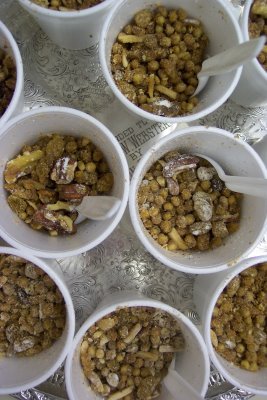 Koliva in cups for distribution to the faithful at the Saturday service. Christ said, "Unless a wheat grain falls into the earth and dies, it remains alone; but if it dies, it bears much fruit." (John 12:24)
Koliva in cups for distribution to the faithful at the Saturday service. Christ said, "Unless a wheat grain falls into the earth and dies, it remains alone; but if it dies, it bears much fruit." (John 12:24)
When planted, the wheat is buried in the soil, but when the season is right, a new plant will grow. So we believe that the Christian will be raised in a new body in the resurrection. Wheat symbolizes the eternal cycle. People like wheat, must be buried to grow and have new life.
Q. What is in Koliva?
A. It is boiled kernels of wheat mixed with dried fruit and nuts. It also can be sweetened with sugar and spices, and covered with powdered sugar to resemble a tomb or grave.
Q. When is it prepared?
A. Preparation begins one day before the scheduled memorial service. Most services are at the end of the Sunday liturgy. Therefore, the wheat needs to be boiled and set to dry on Saturday evening. Invite your family and friends to gather and assemble the other ingredients; share stories and complete the preparation of the Koliva.
Q. Why is it important that we remember those who have fallen asleep?
A. It is important to remember and pray for those who have passed on, to keep their memory alive and to help us heal. As Orthodox Christians, we believe that intercessions on behalf of the dead are possible through the fervent prayers of those remaining on earth (see Matthew 25). We are a church made up of both the living and the dead.
Q. When are memorial services usually observed?
A. The fortieth day after the death of a loved one and the first anniversary of the death are the most commonly observed memorials. Memorials may also be observed on the third, sixth, and ninth months as well as the yearly anniversary. The departed may also be remembered during the scheduled Soul Saturdays throughout the church calendar.
Bible Reading
But I do not want you to be ignorant, brethren, concerning those who have fallen asleep, lest you sorrow as others who have no hope. For if we believe that Jesus died and rose again, even so God will bring with Him those who sleep in Jesus. For this we say to you by the work of the Lord, that we who are alive and remain until the coming of the Lord will by no means precede those who are asleep. For the Lord Himself will descend from heaven with a shout, with the voice of an archangel, and with the trumpet of God. And the dead in Christ will rise first. Then we who are alive and remain shall be caught up together with them in the clouds to meet the Lord in the air. And thus we shall always be with the Lord. Therefore comfort one another with these words (1 Thessalonians 4:13-17).
KOLIVA RECIPE
Ingredients:
1lb. Whole Wheat Berries (hulled/shelled is preferred but not a necessity) [In the Russian Church, boiled rice is also used.]
1 package or 1 cup crushed Arrowroot Biscuits or Graham Crackers
1 cup chopped Walnuts
2 cups confectionery sugar
Ground Cinnamon (to taste)
Powder Vanilla (to taste)
Jordan Almonds (assorted colors) for decoration
Optional ingredients (These should reflect your family’s preferences and heritage and you may use any or all of the ingredients):
1/3 cup Sesame seeds
2 tsp coriander
2 tsp cumin
1/2 cup Pine nuts
1/2 cup Apricot (dried and chopped)
1/2 cup Golden Raisins
1/2 cup dried sweetened cranberries
1/4 cup chopped mint or parsley
Pomegranate seeds
Preparation of the wheat (The night before or at least 6 hours before memorial) [The Greek tradition makes a slightly more ornate koliva than the Russian]:
 Rinse wheat well in colander with cold running water. Place in large stainless steel pot. Fill with water within 3 inches from the top and bring to a gentle boil Stir frequently for 45 minutes to 1 hour (the wheat berries should be "al dente" or chewy but not too soft). Drain-off water and rinse boiled wheat in the colander. Allow to drain in colander for about 1 1/2 hours Toss gently the boiled wheat with rubber spatula to loosen. Prepare a 12 X 17 inch pan lined with clean cotton pillow-case or dish towel. Pour the wheat into pan. Spread the boiled wheat to cover pan and allow drying out 6 to 8 hours or overnight
Rinse wheat well in colander with cold running water. Place in large stainless steel pot. Fill with water within 3 inches from the top and bring to a gentle boil Stir frequently for 45 minutes to 1 hour (the wheat berries should be "al dente" or chewy but not too soft). Drain-off water and rinse boiled wheat in the colander. Allow to drain in colander for about 1 1/2 hours Toss gently the boiled wheat with rubber spatula to loosen. Prepare a 12 X 17 inch pan lined with clean cotton pillow-case or dish towel. Pour the wheat into pan. Spread the boiled wheat to cover pan and allow drying out 6 to 8 hours or overnight
To assemble for church:
Place the following in a large bowl for gentle mixing:
Cooked wheat, walnuts, or your choice of optional add-ins. Gently combine. Line display platter or bowl with paper doily and top with plastic food wrap. Pour koliva mixture onto the platter or bowl and pack down to make firm mound. Sprinkle lightly the cinnamon and powder vanilla on the koliva mound. Sprinkle ground crackers on top of the cinnamon and continue packing. Top with sifted confectionery sugar. Place plastic wrap over mound and pat gently since (this makes packing rather uniform). Repeat and add another layer of sifted confectionery sugar. Decorate with Jordan almonds on the top in the sign of the Cross. On the top right quadrant, place the Greek letter "A" (Alpha means: Christ is the beginning). On the top left quadrant, place the Greek letter "W" (Omega means: Christ the end). On the bottom right quadrant, place the deceased first initial. On the bottom left quadrant, place the deceased last initial. Finally, a candle should be placed in the center of the mound and then presented to the memorial table at church.
Closing Prayer
For Thou, O Christ our God, art the resurrection, the life and the repose of your departed servants, who have fallen asleep and Thee do we glorify together with Thy eternal Father and Thine all-holy, good and life-giving Spirit, now and forever and to the ages of ages. Amen
From: Holy Trinity Marine.org

